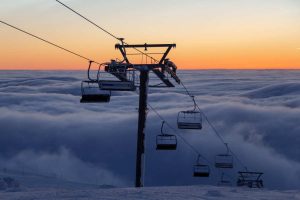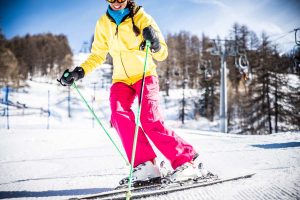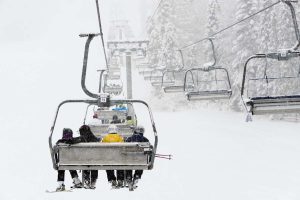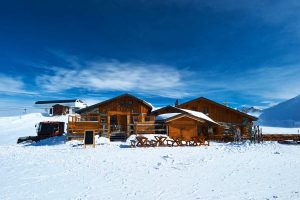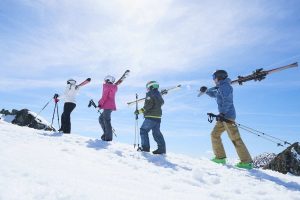Winter ski trips can be a fun and exciting way to spend time with friends and family, but it is vital to ensure you are prepared for anything. From the right clothes to wear on the slopes to the essential safety gear, ensuring you have the right items can make a big difference in a successful ski trip. Outlining the necessary equipment for a ski trip will ensure you are ready to hit the slopes confidently.
What to Wear While Skiing
Suitable clothing and accessories are essential for staying warm and comfortable on the slopes. A good quality ski jacket, pants, and socks are necessary to keep you warm and dry. Make sure to bring a hat, goggles, and ski gloves, as these items will help keep you protected from the elements.
Ski Jacket
A ski jacket is one of the critical pieces of clothing you will need for a ski trip. Look for a water and windproof coat, as these will help keep you dry and warm, even in the coldest conditions. Make sure the jacket fits properly and is comfortable to move around in. Look for a jacket with plenty of pockets to store snacks, a cell phone, or other items you might need.
The best material for ski jackets is a waterproof and windproof fabric, such as Gore-Tex. Gore-Tex is lightweight, breathable, and highly waterproof, making it ideal for ski jackets. It also provides excellent insulation, helping to keep you warm even in cold weather. Other materials, such as fleece or down, can also be used for ski jackets, but they are less waterproof and windproof than Gore-Tex.
The most important features of a ski jacket are waterproofing, windproofing, and insulation. Look for a coat made from a waterproof and windproof material, such as Gore-Tex, to keep you dry and warm. Also, look for a jacket with plenty of pockets to store items, such as snacks and a cell phone. Finally, look for a coat that fits well and is comfortable to move around in.
Ski Pants
Ski pants are essential for keeping your legs warm and dry while skiing. Look for ski pants made from waterproof and windproof materials, such as Gore-Tex. Make sure the pants fit correctly and are comfortable to move around in. Look for pants with plenty of pockets for items such as snacks, a cell phone, or other items you might need.
You should avoid materials such as cotton, which are not waterproof or windproof, and cotton will not keep you warm or dry in cold or wet conditions. Additionally, you should avoid materials that are not breathable, as they can cause you to become uncomfortable and sweaty. Finally, you should use materials that are too thin or lightweight, as they may need to provide more insulation to keep you warm.
Ski Socks
Ski socks are an essential item to bring on a ski trip. Look for a pair of ski socks made from moisture-wicking material, such as wool or synthetic materials. This will help keep your feet dry and warm. Additionally, ensure the socks fit correctly, as too-tight socks can cause discomfort and blisters.
Ski socks offer several benefits. They help keep your feet dry and warm by wicking moisture away from the skin. Additionally, they can help reduce the risk of blisters and other foot injuries by providing cushioning and support. Finally, by providing insulation and warmth, ski socks can also help reduce the risk of cold-related injuries, such as frostbite.
Warm Hat
Don’t forget to bring a hat along. Look for a cap made from a warm, breathable material, such as wool or synthetic materials. Ensure the hat fits appropriately, as too-tight can be uncomfortable and cause headaches. Additionally, look for a hat with a brim or a visor to protect your eyes from the sun.
Wearing a hat while skiing is a good idea. It helps keep your head warm and can protect your scalp from the sun’s rays. Additionally, a hat can help protect your ears from the wind and cold. Finally, a hat can help reduce the risk of cold-related injuries, such as frostbite, by providing extra insulation and warmth.
Goggles
Look for a pair of goggles that fit correctly and are comfortable. Ensure the lenses are made from a durable material, such as polycarbonate, and they provide adequate UV protection. Additionally, look for goggles with anti-fog lenses, as this will help keep your vision clear.
There are several important reasons to wear goggles when skiing. They can protect your eyes from the sun’s UV rays and wind, snow, and debris. Additionally, goggles can help improve visibility in low-light conditions, and anti-fog lenses can help keep your vision clear. Finally, goggles can help reduce the risk of cold-related injuries, such as frostbite, by providing extra insulation and warmth.
Ski Gloves
You won’t have a good time if you don’t wear gloves. Try to find gloves made from waterproof and windproof materials, such as Gore-Tex. Make sure the gloves fit properly and are comfortable to wear. Additionally, look for gloves with insulation, as this will help keep your hands warm.
Wearing gloves help keep your hands warm and dry, even in cold and wet conditions. Additionally, gloves can provide extra grip on the ski poles, which can help improve your control and performance. Finally, gloves can help reduce the risk of cold-related injuries, such as frostbite, by providing extra insulation and warmth.
It would help if you avoided gloves that are not waterproof or windproof, as these will not keep your hands warm and dry in cold and wet conditions. Additionally, it would be best to avoid gloves that are too bulky or too thin, as these can be uncomfortable or provide insufficient insulation. Finally, avoid gloves made from cotton, as this material is not waterproof or windproof.
Important Safety Gear
Skiing can be a dangerous activity, so it is vital to make sure you have the proper safety gear. A helmet is a must-have item and can help protect you from serious head injuries, and ski poles can also help maintain your balance and improve your performance. An avalanche beacon, shovel, and first aid kit are essential for safely navigating the slopes.
Helmet
A helmet is an valuable piece of safety gear when skiing. Try to wear a helmet that fits properly and is made from a durable material, such as polycarbonate. Ensure the helmet meets safety standards, such as ASTM or CE, and has adequate ventilation. Additionally, look for a helmet with a built-in visor, as this can help protect your eyes from the sun.
Even if you don’t ski recklessly, a helmet can save your life. It can help protect your head from severe injury, wind, snow, and debris. Additionally, a helmet can help improve balance and performance, as it helps to keep your head warm and comfortable. Finally, a helmet can help reduce the risk of cold-related injuries, such as frostbite, by providing extra insulation and warmth.
You should avoid helmets not made from a durable material, such as polycarbonate. Additionally, you should prevent helmets that are not certified to meet safety standards, such as ASTM or CE. Finally, steer clear of too bulky or heavy helmets, which can be uncomfortable and cause fatigue.
Ski Poles
When shopping for ski poles try to choose poles made from a durable material, such as aluminum or carbon fiber. Make sure the poles are the correct length for your height and are comfortable to hold. Additionally, look for adjustable poles, as this can help you find the perfect size for your skiing style.
Using ski poles while skiing can help maintain balance, improve performance, and even help you navigate the slopes. Additionally, ski poles can help reduce fatigue, as it helps to spread a load of your body weight more evenly. Finally, by providing extra insulation and warmth, ski poles can also help reduce the risk of cold-related injuries, such as frostbite.
Avalanche Beacon
An avalanche beacon is lightweight and easy to use. Make sure the beacon is compatible with other beacons, as this will help ensure you can be found if you get lost. You may want to look for a beacon with a built-in digital display, which can provide additional information about the terrain.
Using an avalanche beacon while skiing can help you locate other skiers in the event of an avalanche, and it can also help rescuers find you if you get lost. Additionally, a beacon can help you navigate the terrain, as it can provide information about the slope angle and snow depth. Finally, a beacon can help reduce the risk of cold-related injuries, such as frostbite, by providing extra insulation and warmth.
Backpacking Shovel
While most people might not consider a shovel to be a critical safety item when skiing, it can be a life saver. The type of shovel you want is a lightweight, compact shovel yet still durable enough to handle the rigors of the slopes. Make sure the shovel is easy to use and can fit in your backpack. Look for a shovel with a built-in handle, as this can help make the shovel easier to use.
Carrying a shovel while skiing can help you dig out if you get stuck in the snow, and it can also help you build jumps or dig pits for practicing tricks. Additionally, a shovel can help you clear debris from the slopes and create a safe area to rest or take a break. Finally, a shovel can help reduce the risk of cold-related injuries, such as frostbite, by providing extra insulation and warmth.
First Aid Kit
I don’t need to explain the value of a first aid kit. The right kit for skiing should include the basics, such as bandages, antiseptic wipes, and an ice pack. Ensure the kit is easy to access and contains any medication you or your group might need. Additionally, purchase a kit with a built-in flashlight, as this can be helpful in low-light conditions.
Your first aid kit will help you in several ways in an emergency. It can help treat minor injuries, such as cuts, scrapes, and bruises. Additionally, a first aid kit can provide items to help treat more severe injuries, such as broken bones. Finally, a first aid kit can help reduce the risk of cold-related injuries, such as frostbite, by providing extra insulation and warmth.
These are some items you should ensure are in your first aid kit:
- Bandages
- Antiseptic wipes
- Tweezers
- Adhesive tape
- Scissors
- Any medication you or your group might need
- You may want to include a flashlight, a thermometer, and a map in your first aid kit.
Miscellaneous Items
Even the best-prepared ski trips can be improved by having some miscellaneous items. A water bottle is essential for staying hydrated on the slopes, and sunscreen can help protect your skin from the sun, while snacks can boost energy. Cell phones, cameras, and maps can help navigate the slopes and capture memories.
Water Bottle
You don’t want to become dehydrated on the slopes. Bring a water bottle made from a durable material, such as stainless steel. Make sure the bottle is easy to open and has a wide mouth, making it easier to drink. Additionally, look for a bottle with a built-in filter, as this can help ensure the water is clean and safe to drink.
A water bottle while skiing can help you stay hydrated, even in cold and dry conditions. A water bottle can help reduce fatigue, providing a quick energy boost. Finally, a water bottle can help reduce the risk of cold-related injuries, such as frostbite, by providing extra insulation and warmth.
Sunscreen
The snow reflects sunlight and can cause severe sunburns if you aren’t prepared. You’ll want a broad-spectrum sunscreen with an SPF of at least 30. Ensure the sunscreen is waterproof and sweat-resistant, which will help ensure it will last throughout the day. Additionally, you may want to look for a sunscreen specifically designed for skiing, as these often contain additional ingredients to protect your skin from the sun.
Wearing sunscreen while skiing is a wise idea. It can help protect your skin from the sun’s UV rays, which can cause sunburns, premature aging, and even skin cancer. Additionally, sunscreen can help reduce the risk of cold-related injuries, such as frostbite, by providing extra insulation and warmth. Finally, sunscreen can help reduce glare, improving visibility in low-light conditions.
Snacks
Snacks are a no-brainer to bring skiing. Skiing is an active sport and can really work up an appetite. Pack snacks that are lightweight and easy to carry, such as energy bars or trail mix. Snacks should be non-perishable and have a long shelf life, which will help ensure they stay fresh throughout the day. Additionally, look for snacks that contain protein and complex carbohydrates, as these can boost energy when needed.
Stopping to eat a quick snack can help provide a quick boost of energy when needed, as well as help maintain blood sugar levels. Additionally, snacks can help reduce fatigue, as they can provide an additional source of energy. Finally, by providing extra insulation and warmth, snacks can also help reduce the risk of cold-related injuries, such as frostbite.
Cell Phone
When your up on the slopes, don’t forget your cellphone. Ideally, you should bring a waterproof and rugged phone, as this will help ensure it will last through the day. Make sure the phone is fully charged, which will help you stay connected. Additionally, look for a phone with a built-in GPS, as this can help you find your way if you get lost.
Having a cellphone while skiing can help you stay connected with your group and be used to call for help if needed. Additionally, a cell phone can help you navigate the terrain, as it can provide information about the slope angle and snow depth. Finally, a cell phone can help reduce the risk of cold-related injuries, such as frostbite, by providing extra insulation and warmth.
Camera
Don’t forget your camera so you can capture those great memories! Try to find a lightweight and easy camera to use, as this will make it easier to capture the perfect shot. Make sure the camera has a wide-angle lens, as this will allow you to capture more of the scenery. Additionally, look for a camera with built-in image stabilization, as this can help reduce camera shake and blur.
It’s easy to forget to bring your camera, but if you leave it behind, you’ll regret it when you get home. It can help you capture memories and provide you with a photo diary of your ski trip. Additionally, a camera can help you navigate the terrain, as it can give information on the slope angle and snow depth. Finally, a camera can help reduce the risk of cold-related injuries, such as frostbite, by providing extra insulation and warmth.
Maps
When you’re out skiing, don’t leave without a map of the area you are skiing in. The map should be detailed and easy-to-reread maps, as this will make it easier to find your way. Please ensure the maps are waterproof and tear-resistant, as this will help ensure they last throughout the day. Additionally, look for maps that include trail markers, as this can help you stay on the right path.
Having maps while skiing can help you find your way if you get lost and help you navigate the terrain, as it can provide information about the slope angle and snow depth. Also, maps help reduce fatigue, providing an easy reference for finding your way. Finally, by providing extra insulation and warmth, maps can also help reduce the risk of cold-related injuries, such as frostbite.
Make Sure You Have the Right Gear
Taking the time to ensure you have the right gear for a ski trip can make all the difference in having a safe and enjoyable experience. From the essential items, such as a ski jacket and helmet, to the miscellaneous items, such as a water bottle and maps, having the right gear will help ensure you are ready for anything. Make sure to check the weather conditions before you go and pack accordingly.
More Skiing Posts
Tylor Bennett
An editor at Outdoors ReportTylor Bennett is a senior editor for the blogzine and also reports on breaking news based in London. He has written about government, criminal justice, and the role of money in politics since 2015.



